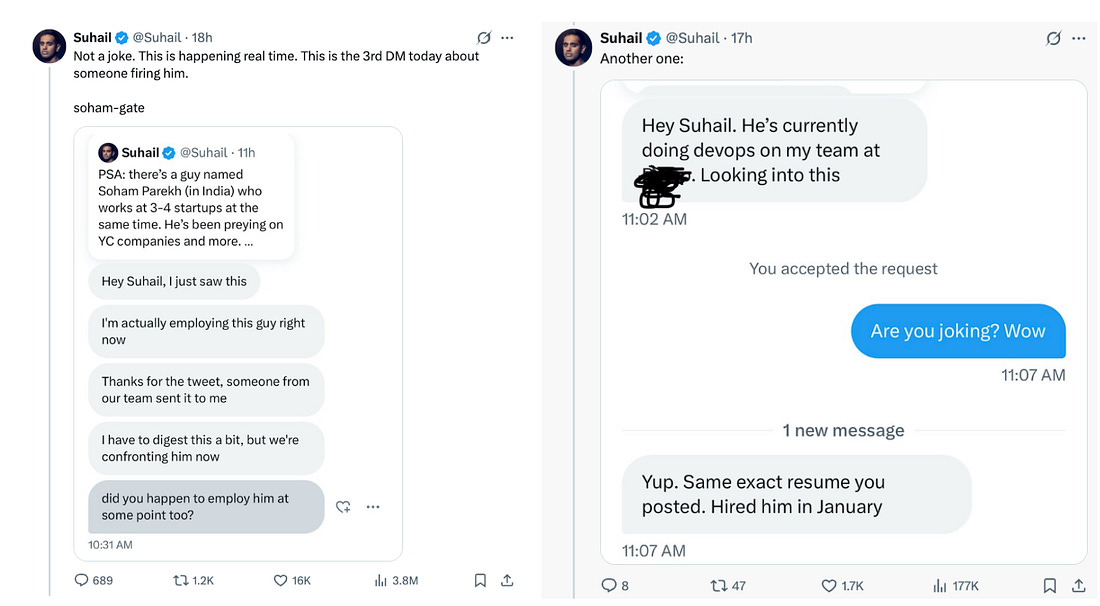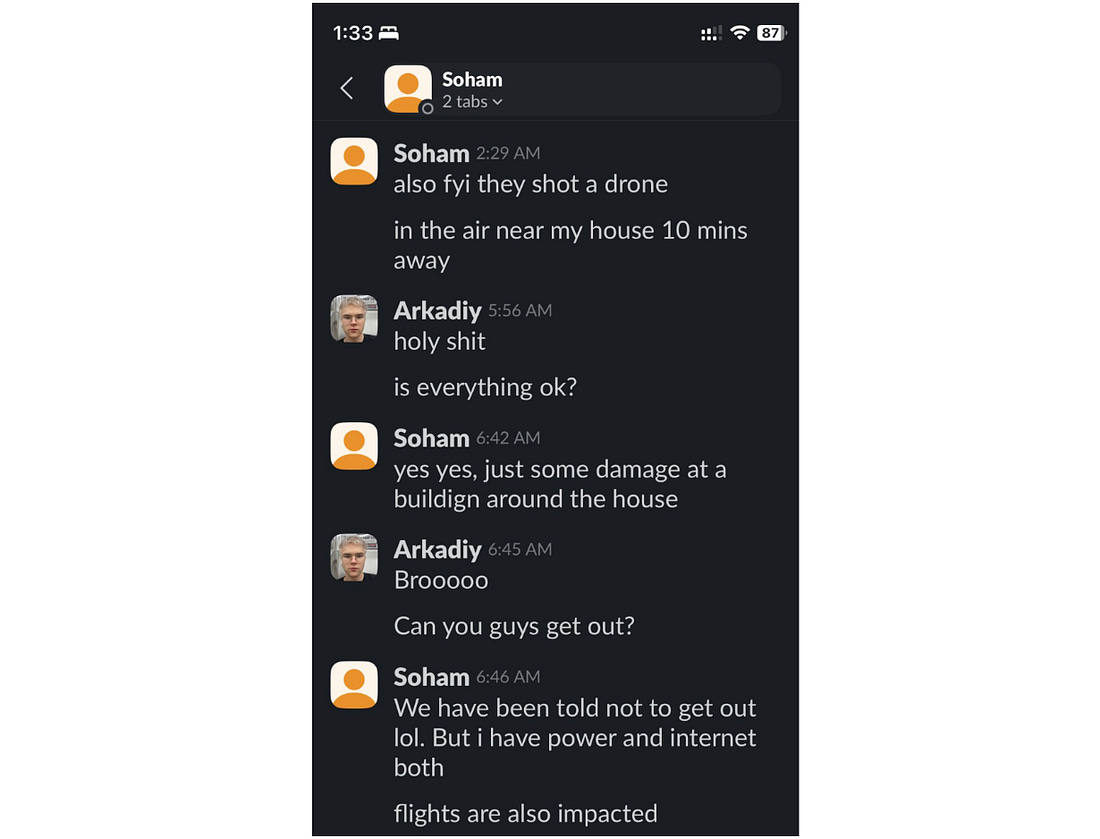The 10x “overlemployed” engineer
👋 Hi, this is Gergely with a subscriber-only issue of the Pragmatic Engineer Newsletter. In every issue, I cover challenges at Big Tech and startups through the lens of engineering managers and senior engineers. If you’ve been forwarded this email, you can subscribe here. The 10x “overlemployed” engineerA software engineer worked at several AI startups at the same time, without his employers knowing anything about it. Then one frustrated founder who hired him went public…The 2002 movie Catch Me if You Can stars Leonardo Di Caprio as a talented 19-year-old fraudster, who forges millions of dollars in checks while pretending to be a doctor, a lawyer, and even an airline pilot. That Hollywood film now has echoes in the tech industry, in a story which has come to light in Silicon Valley. A software engineer in their mid-twenties, based in India, successfully scammed approximately a million dollars annually from tech startups by excelling in interviews, getting hired remotely, and then not doing their assigned work, all while being simultaneously employed by many companies. As in ‘Catch Me if You Can’, in this story there’s an unusually talented main character who gets into a dramatic showdown once exposed. Today’s issue covers what happened, and some learnings from this highly unusual incident:
The bottom of this article could be cut off in some email clients. Read the full article uninterrupted, online. 1. ExposéYesterday (2 July), startup founder Suhail Doshi made an accusation: that a software engineer named Soham Parekh was working at several Y Combinator startups at once, and had been doing so for over a year, all while failing to do the work he was hired to do:
Initially, the post got a bit of pushback. After all, in California – where most startups which hired Parekh are based – it’s not forbidden to have a second job (aka ‘moonlighting’), as long as it doesn’t overlap with other commitments. Indeed, many leaders founded startups on the side of their main job, and an employer cannot claim intellectual property ownership of a new project which is fully separate from someone’s primary job. What makes this story stand out is the unusually high number of parallel jobs this one dev took on. All together, the combined workload of all these roles was evidently impossible to maintain, and would inevitably lead to questions being asked by individual employers, who wondered why a clearly-talented engineer was unable to deliver their work. Suhail said his issue was not that Parekh had a side job; it was something more fundamental:
Initially, the post got a bit of pushback. After all, in California – where most startups which hired Parekh are based – it’s not forbidden to have a second job (aka ‘moonlighting’), as long as it doesn’t overlap with other commitments. Indeed, many leaders founded startups on the side of their main job, and an employer cannot claim intellectual property ownership of a new project which is fully separate from someone’s primary job. What makes this story stand out is the unusually high number of parallel jobs this one dev took on. All together, the combined workload of all these roles was evidently impossible to maintain, and would inevitably lead to questions being asked by individual employers, who wondered why a clearly-talented engineer was unable to deliver their work. Suhail said his issue was not that Parekh had a side job; it was something more fundamental:
Following Suhail’s post, reports from other startups began to emerge, with accusations that they had hired Parekh, and then fired him not long afterward. He was exposed thanks to the Y Combinator founder community. Doshi went public with accusations after confirming with several other Y Combinator founders who’d had the same experience with Parekh. Garry Tan – president and CEO of Y Combinator – also shared his belief that without the Y Combinator founder community sharing information with one another, Parekh might have not been publicly exposed. 2. 18 companies that hired, or nearly hired himAs the drama played out online, things turned bad fast for Parekh. Other companies at which he worked reportedly started taking action, as per Suhail:
Many companies went on record about the fact they had employed and quickly dismissed Parekh. Links to companies below lead to their job pages, if they have one. All are hiring for fullstack software engineers or AI engineers.
Then there are companies which interviewed Soham, but decided against employing him:
A startup advocating for “cheating on everything” also nearly got duped. Cluey is a startup building an AI tool to “cheat on everything”, and as fate would have it, the company’s founder and CEO shared that they were at the second-round interview stage with Parekh. The company shared interview notes taken during their session:
3. Excuses, excuses…Parekh consistently delayed his supposedly-imminent relocation to the US. Most startups that employed him usually knew he was based in India, but all assumed he wanted to relocate to the US. He assured several employers that he was taking care of his O1 visa (discussed below). For example, here is an email sent to the CEO of Fleet AI:
Excuses were frequent. One recurring feature was Parekh’s creative excuses for why he was slow at getting things done. Arkadiy Telegin, cofounder of Leaping AI, wondered why it took him so long to do pull requests. Parekh replied that a military drone had damaged his house during fighting between India and Pakistan. Later, it turned out he was not near the conflict zone:
It’s alleged Soham misled at least one employer about his location. A founder said they thought he was US-based, and even showed a company laptop sent to a US address. The laptop was later returned – Soham claimed it was sent to his sister. However, he never had a US address, and could not have one legally since he did not have any USA visa. Igor Zalutski, founder of Digger (AI that understands infrastructure) gave me examples of what it was like working with Soham:
Digger AI terminated Soham’s contract a day or two into his onboarding. By that time, they had placed an order for an Apple laptop to be shipped to Parekh’s home address in India. Luckily, they could still cancel the order. 4. Skyrocketing demand for AI engineersOne puzzling part of the story is how he got hired by Silicon Valley startups, particularly by “cream of the crop” places like Y Combinator AI startups. These businesses are well-funded, offer good base salaries close to the $200K/year range for senior engineers, and also attract more candidates than average. But the reality is complicated, and also explains why some parts of the tech market are still “candidate’s markets”, compared to the norm. This is a reminder that becoming an “AI engineer” as a software engineer is straightforward enough: we covered Seven examples of software engineers picking up AI engineering, The “AI engineering stack” with Chip Huyen, and How Janvi Kalra became an AI Engineer at Coda — which later helped her get hired at OpenAI. This is why the market is so hot for AI engineers:... Subscribe to The Pragmatic Engineer to unlock the rest.Become a paying subscriber of The Pragmatic Engineer to get access to this post and other subscriber-only content. A subscription gets you:
|







Comments
Post a Comment